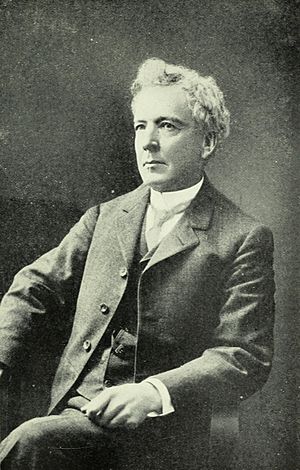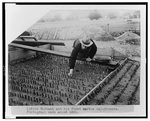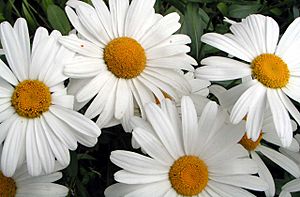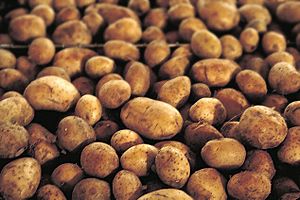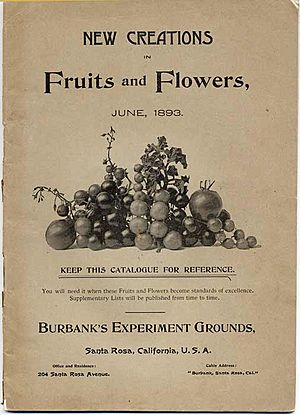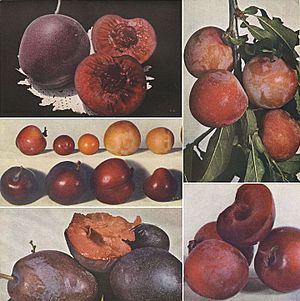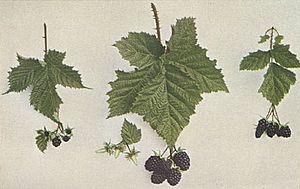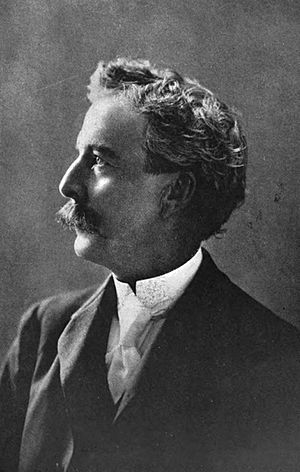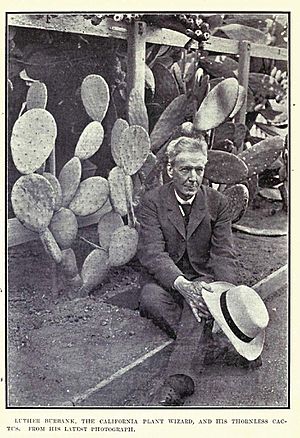Luther Burbank facts for kids
Quick facts for kids
Luther Burbank
|
|
|---|---|
 |
|
| Born | March 7, 1849 |
| Died | April 11, 1926 (aged 77) |
| Spouse(s) | Helen Coleman, Elizabeth Waters |
| Children | None |
| Scientific career | |
| Fields | Botany |
| Patrons | Andrew Carnegie |
| Author abbrev. (botany) | Burbank |
| Signature | |
 |
|
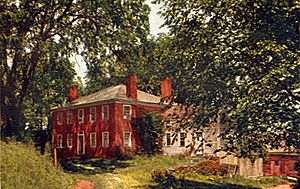
Luther Burbank (March 7, 1849 – April 11, 1926) was an American botanist and horticulturist. He was a pioneer in agricultural science, which is the study of how to grow crops and raise animals.
Over his 55-year career, Burbank developed more than 800 new types of plants. These included many different fruits, flowers, grains, grasses, and vegetables. He is famous for creating a spineless cactus (which is useful for feeding cattle) and the plumcot, a fruit that is a mix of a plum and an apricot.
Some of Burbank's most well-known creations include the Shasta daisy, the "Santa Rosa" plum, and the "July Elberta" peach. He also developed the russet Burbank potato. This large, brown-skinned potato with white flesh is now the most common type of potato used in food processing around the world. The Russet Burbank potato was very important in helping Ireland after the Great Famine, as it was more resistant to a disease called late blight that destroyed potato crops.
Contents
Luther Burbank's Life and Work
Burbank was born in Lancaster, Massachusetts, and grew up on a farm. He only had a high school education. As one of fifteen children, he loved spending time in his mother's large garden. When he was 18, his father passed away. Burbank used his inheritance to buy a 17-acre plot of land near Lunenburg.
There, he developed his first famous plant: the Burbank potato. He sold the rights to this potato for $150. With that money, he moved to Santa Rosa, California, in 1875. Later, a natural change in the Burbank potato created the Russet Burbank potato with its russet-colored skin. Today, the Russet Burbank potato is the most widely grown potato in the United States. It's popular because it stays fresh longer than other potatoes. A large number of McDonald's french fries are made from this potato!
In Santa Rosa, Burbank bought a 4-acre plot of land. He built a greenhouse, a plant nursery, and experimental fields. Here, he did many crossbreeding experiments on plants. He was inspired by Charles Darwin's book about how animals and plants change over time. This site is now a public park called Luther Burbank Home and Gardens. Later, he bought another 18-acre farm in nearby Sebastopol, which he called Gold Ridge Farm.
Burbank became famous through his plant catalogs, especially "New Creations in Fruits and Flowers" from 1893. People also spread the word about his amazing plants, and newspapers often wrote about him.
In 1893, Stark Bro's Nurseries & Orchards Co. found a new type of apple called the 'Delicious' apple. It had an unusual shape. Burbank, who was already famous for grafting and budding plants, called this new 'Delicious' apple "the finest-flavored apple in all the world." This was the beginning of a long partnership between Burbank and Stark Bro's.
Clarence McDowell Stark, from Stark Bro's, visited Burbank in Santa Rosa. He saw how Burbank was struggling to fund his experiments by running a small seed business. Clarence realized Burbank needed more support to achieve his full potential. He offered Burbank $9,000 if he could choose three of Burbank's new fruits. This money helped Burbank greatly.
Burbank often said that the Stark family helped make his work successful. Later, he even worked with Thomas Edison to support laws that would allow plant breeders to get patents for their new plant varieties. This would protect their inventions.
From 1904 to 1909, Burbank received money from the Carnegie Institution to help with his research. Andrew Carnegie himself supported Burbank, even though some of his advisors thought Burbank's methods were not "scientific" enough.
Luther Burbank became ill in his last two weeks and passed away on April 11, 1926. He was 77 years old. He was buried in an unmarked grave under a large Cedar of Lebanon tree at the Luther Burbank Home and Gardens in Santa Rosa, California.
Before he died, Burbank told his wife, Elizabeth, that only a few organizations in the world could continue his work. He believed Stark Bro's Nurseries & Orchards Co. was the best choice. After his death, Elizabeth Burbank made an agreement with Stark Bro's in 1927. They took many of Burbank's plants and precious seeds. They also got the rights to his business name and customer information. Stark Bro's then introduced many of Burbank's amazing new fruits and flowers, which included 120 types of plums, 500 hybrid roses, and many more.
Over the next few years, Elizabeth worked with the Stark brothers to get patents for 16 of Burbank's fruits and flowers. These patents named Luther Burbank as the "inventor."
Burbank's Plant Creations
Burbank created hundreds of new types of fruits, vegetables, and ornamental flowers. He introduced over 800 new plants, including many different flowers, grains, grasses, and fruits.
Here are some of the types of plants he created:
- 113 plums and prunes
- 69 nuts
- 35 fruiting cactus
- 16 blackberries
- 13 raspberries
- 11 quinces
- 11 plumcots
- 10 cherries
- 10 strawberries
- 10 apples
- 8 peaches
- 6 chestnuts
- 5 nectarines
- 4 grapes
- 4 pears
- 3 walnuts
- 2 figs
- 1 almond
- 9 types of berries
- 26 types of vegetables
- 91 types of ornamental plants
Burbank's method for creating new plants seemed simple, but it was very hard work. He would often grow 10,000 or more plants of one variety. From these, he would carefully choose only a few, sometimes just one, that had the traits he wanted. He would then grow another 10,000 seedlings from those chosen plants, continuing this process until he got the perfect result. For example, he managed to make chestnut trees produce fruit in just three years, instead of the usual 25 years. His creations included a clear white blackberry, a juicy and large plum, a spineless cactus, and a fragrant calla lily.
Burbank's Publications
Burbank was sometimes criticized by scientists because he didn't keep detailed records of his experiments. He was more interested in creating useful plants than in writing down every step of his research. He felt his time was better spent working in the garden.
In 1893, Burbank published a catalog called New Creations in Fruits and Flowers, describing some of his best plant varieties.
During his career, Burbank wrote several books about his methods and discoveries. These included his eight-volume series How Plants Are Trained to Work for Man (1921) and Partner of Nature (1939).
How Burbank Bred Plants
Burbank used different techniques to create new plants, such as grafting (joining parts of two plants), hybridization (crossing two different types of plants), and cross-breeding.
Classical Plant Breeding Methods
Classical plant breeding involves carefully crossing different plants to create new varieties with desired features. For example, a pea plant that resists mildew might be crossed with a pea plant that produces a lot of peas but is not resistant. The goal is to get a new pea plant that resists mildew and also produces a lot of peas.
Breeders use this method to add good traits to crop plants. Some traits that breeders have tried to add in the last 100 years include:
- Making crops better quality and produce more food.
- Helping plants survive in tough conditions like salty soil, very hot or cold temperatures, or dry weather.
- Making plants resistant to viruses, fungi, and bacteria.
- Helping plants resist insect pests.
- Making plants more tolerant to herbicides (chemicals that kill weeds).
Mass Selection
Burbank would often cross-pollinate flowers by hand. Then, he would plant all the seeds that resulted from this cross. From the thousands of plants that grew, he would carefully choose the most promising ones to cross again. This process of selecting the best plants over and over is called mass selection.
Luther Burbank's Personal Life
People admired Burbank not only for his amazing gardening skills but also for his modesty, kindness, and generosity. He cared a lot about education and gave money to local schools.
He was married twice: first to Helen Coleman in 1890, and later to Elizabeth Waters in 1916. He did not have any biological children but adopted a daughter.
Luther Burbank was highly respected across the United States. In 1905, a group of important California leaders held a banquet in his honor. Many people spoke about Burbank, praising his work and saying he could teach the government valuable lessons.
Luther Burbank's Legacy
California's Arbor Day is celebrated on March 7, Luther Burbank's birthday, in his honor.
Burbank's work helped lead to the passing of the 1930 Plant Patent Act, four years after his death. This law made it possible for people to get patents for new plant varieties, protecting their inventions. Thomas Edison supported this law, saying it would give the country "many Burbanks." Burbank was given 16 plant patents posthumously (after his death).
In 1931, the artist Frida Kahlo painted a portrait of Burbank as a tree growing from his grave.
In 1940, the U.S. Postal Service released a 3-cent stamp honoring Burbank.
In 1986, Burbank was inducted into the National Inventors Hall of Fame. His home and gardens in Santa Rosa, California, are now a National Historic Landmark. His experiment farm in Sebastopol, California, is listed in the National Register of Historic Places.
Luther Burbank's birthplace and his California garden office were moved by Henry Ford to Dearborn, Michigan, and are now part of Greenfield Village.
Many places and institutions are named after Luther Burbank, including:
- Luther Burbank Center for the Arts, a large building in Santa Rosa, California
- Luther Burbank High School in Sacramento, California
- Luther Burbank High School in San Antonio, Texas
- The Luther Burbank School District in San Jose, California
- Luther Burbank Middle School in Lancaster, Massachusetts
- Luther Burbank Middle School in Highland Park, California
- Several Luther Burbank Elementary Schools across the U.S.
- Luther Burbank Park in Mercer Island, Washington
- The towns of Burbank, Washington and Burbank, Illinois
- Luther Burbank Savings, a bank in Santa Rosa
- Several plant varieties, like Canna 'Burbank' and Chrysanthemum burbankii.
See also
 In Spanish: Luther Burbank para niños
In Spanish: Luther Burbank para niños


